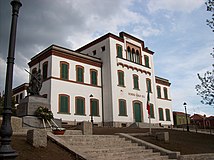A mill town, also known as factory town or mill village, is typically a settlement that developed around one or more mills or factories, often cotton mills or factories producing textiles.

A model village is a type of mostly self-contained community, built from the late 18th century onwards by landowners and business magnates to house their workers. Although the villages are located close to the workplace, they are generally physically separated from them and often consist of relatively high-quality housing, with integrated community amenities and attractive physical environments. "Model" is used in the sense of an ideal to which other developments could aspire.

Capriate San Gervasio is a town and comune in the province of Bergamo, in Lombardy, northern Italy. As of 2019, its population was 8,216.

Busto Arsizio is a comune (municipality) in the south-easternmost part of the province of Varese, in the Italian region of Lombardy, 35 kilometres (22 mi) north of Milan. The economy of Busto Arsizio is mainly based on industry and commerce. It is the fifth municipality in the region by population and the first in the province.
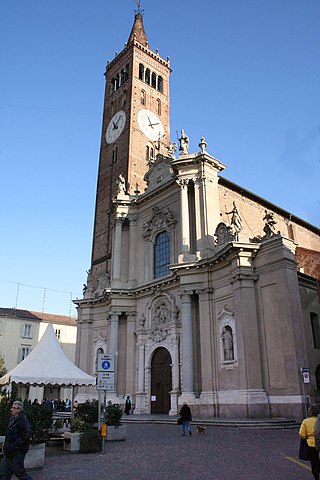
Treviglio is a town and comune in the province of Bergamo, in Lombardy, Northern Italy. It lies 20 kilometres south of the province capital, in the lower territory called Bassa Bergamasca.

Cassano d'Adda is a town and comune in the Metropolitan City of Milan, Lombardy, Italy, located on the right side of the Adda River. It is on the border of the Metropolitan City of Milan and the province of Bergamo. It is served by Cassano d'Adda railway station.

The Battle of Cassano was fought in 1799 from 27 to 28 April near Cassano d'Adda, which about 28 km (17 mi) ENE of Milan. The clash is part of the battle of the Adda River or the so-called forcing of the Adda, which on the first day of 26 April resulted in a minor victory for the Russians under the Count Suvorov over Barthélemy Schérer's French forces at Lecco. Then, on the second day, Suvorov's Austrians and Cossacks prevailed over Jean Moreau's army, who replaced Schérer as supreme commander, and trapped his isolated division on the third. The action took place during the War of the Second Coalition, as part of the larger conflict known as the French Revolutionary Wars.
Crespi is a surname. Notable people with the surname include:

Trezzo sull'Adda is a comune (municipality) in the Metropolitan City of Milan in the Italian region Lombardy, located about 30 kilometres (19 mi) northeast of Milan on the Adda River.
Suisio is a municipality in the Italian region of Lombardy, located about 35 kilometres (22 mi) northeast of Milan and about 20 (12 mi) kilometers west of Bergamo. It had a population of 3 794 inhabitants and an area of 4.6 square kilometres (1.8 sq mi).
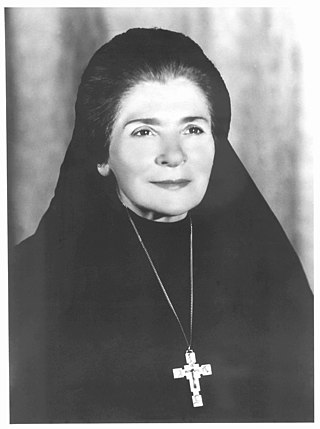
Eugenia Ravasio, OLA, born Eugenia Elisabetta Ravasio, was an Italian Catholic nun in the Congregation of the Missionary Sisters of Our Lady of the Apostles and a mystic, best known for treating leprosy and for having reported visions and revelations from God the Father.

Cristoforo Benigno Crespi was an Italian entrepreneur.
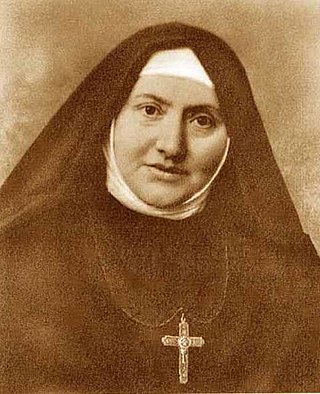
Geltrude Caterina Comensoli, also known as Mother Geltrude is the Patron of Youth, Val Camonica and Relic Custodians.

The Museum of Textiles and Industry is one of the two museums in Busto Arsizio, Italy, that specialises in spinning and weaving. It was opened in 1997 to house objects, pictures and archive material representing Busto Arsizio's industrial history.

Antonio Percassi is an Italian former footballer and entrepreneur.
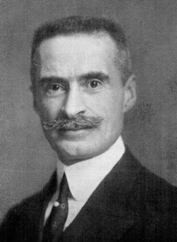
Silvio Benigno Crespi was an Italian entrepreneur, inventor and politician. Firstborn of Cristoforo Benigno Crespi and Pia Travelli. He succeeded his father in running the firm of Crespi d'Adda, today a UNESCO World Heritage Site that is considered notable for being a 19th and 20th century company town which reflected enlightened industrialists' respect for their employees.

The San Michele Bridge, also known as the Paderno Bridge, is a multi-level rail and road truss arch bridge across the Adda River in Lombardy, Italy. The bridge connects Paderno d'Adda, Lecco on the west bank with Calusco d'Adda, Bergamo on the east bank.

The Monumental Cemetery of Mortara is located in the north-eastern outskirts of the city of Mortara, an Italian comune in the province of Pavia, in the region of Lombardy in northern Italy. The Monumental Cemetery of Mortara is one of the biggest and most important cemeteries in the Lomellina area.

The Filatoio Rosso di Caraglio is a historic building located on the outskirts of Caraglio, a town in the province of Cuneo. It houses the Piedmontese Silk Mill Museum, and is a site of cultural events for the area. It is considered to be one of the oldest preserved industrial sites in Europe. Built between 1676 and 1678 on the initiative of Count Giovanni Girolamo Galleani, it was one of the first silk production plants in the Duchy of Savoy and throughout Europe. The enterprise covered the entire production chain of the silk thread from the cultivation of mulberry trees in the surrounding countryside for the breeding of silkworms to the processing of the silk cocoons and creation of the finished product. It was one of the first water-powered spinning mills built in Piedmont.
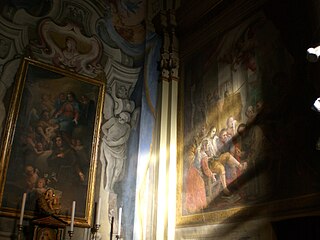
Although it has been characterized in recent centuries as an essentially industrial city, Busto Arsizio counts among its most valuable buildings the numerous monuments of an ecclesiastical nature, testifying to the deep religiosity of its people. Of particular note are the Sanctuary of Santa Maria di Piazza, the Basilica of St. John the Baptist, and the Church of San Michele Arcangelo.









